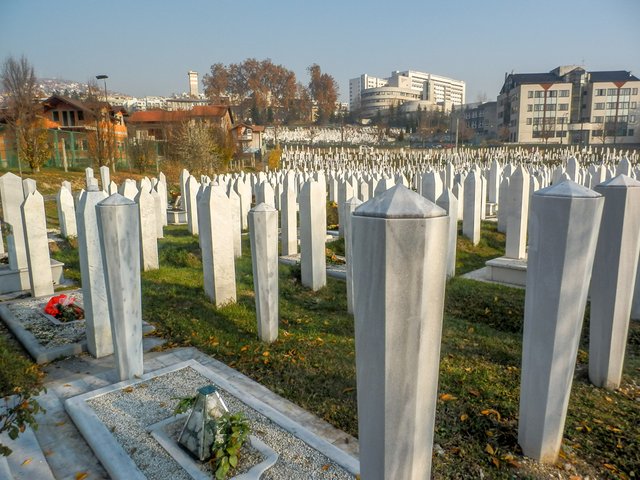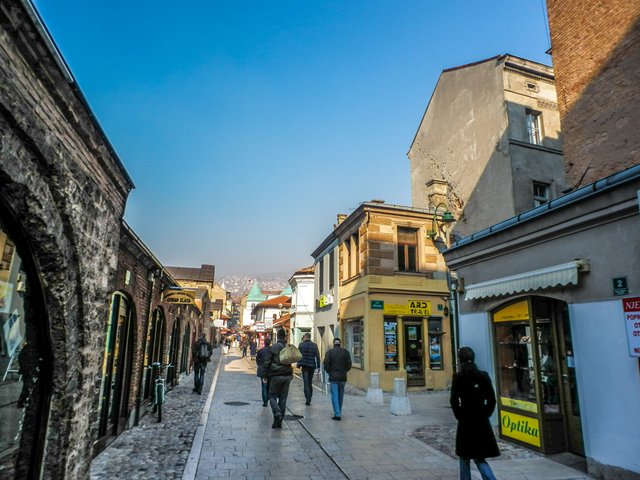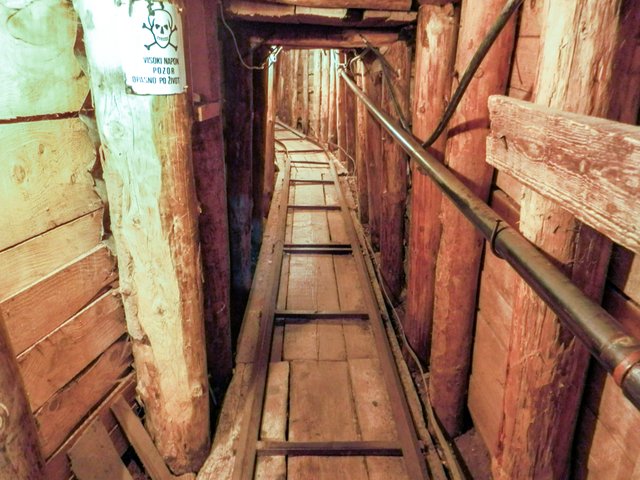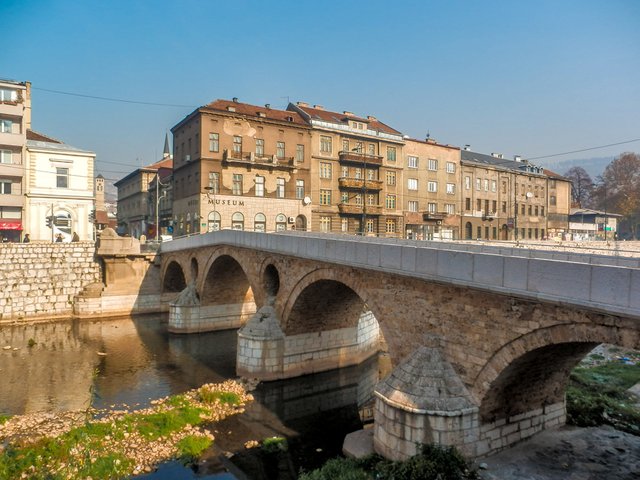Battle scared Sarajevo, Bosnia and Herzegovina

My taxi driver from the airport asks what brings me to Sarajevo. He is surprised a female travelling alone would come all the way from Australia to Bosnia. On the way into town, he proudly points out buildings, new shopping malls, bombed out remains. A new apartment high rise which he informs me no one can afford to move into. “Look, you look. I drive” he insists constantly after excitedly showing me another landmark.
I give him a $US5.00 tip which he is extremely thankful for. I am thankful for his insight and friendliness. During my short time in Sarajevo I notice he is not the only one who welcomes tourists to their homeland after the end of the Bosnian War 17 years ago.
The scars still remain on the majority of buildings with bullet holes and mortar damage roughly patched up with bricks. There has been limited and selective reconstruction done. Like the infamous Parliament building and twin office towers which were bombed out symbols seen worldwide on our television screens during the Sarajevo siege.
I found this damage characteristically interesting and a heavy reminder of the relatively recent dark past of Sarajevo.
Sarajevo spreads out in the valley between good sized mountains with numerous houses perched above. I ask a local if those houses with a view are expensive and told “not really”. No one has a lot of money in Sarajevo as people struggle on after the war.
It is not uncommon to see women on the street selling their meagre possessions like clothing or household goods. They seem desperate as they push an ugly striped cardigan in your face. There are the usual barefooted beggars on the street but not too many. I imagine in summer there would be an overabundance.
 Sarajevo old town street
Sarajevo old town street
One thing you notice fairly quickly is that Bosnians love to smoke. Everywhere is a smoking zone and therefore not uncommon to walk around a supermarket and see someone pushing a trolley with a cigarette in hand. Old women who look like they are almost dead puffing away. Smoking while eating in restaurants like the old days where I come from.
Easy to walk around, Sarajevo has a character all of its own. The small old town (Bascarsija) with Catholic and Christian Churches next to Mosques.
There is a large Turkish influence and excellent eating choices such as Cevapcici, Boreks and Pijeskavica. The first Bosnian McDonalds was open mid 2010 and popular with the younger crowd, why would anyone want to eat there when such great local food available?
There is no real tourist set up here as yet, which is good and bad. Good as its not expensive to see what is there, bad because most is hard to reach without decent infrastructure and usually have to know the Bosnian language.
The Tunnel Museum of the Kolar family is hard to find. Located behind the airport, it is possible to reach by taxi and is well worth a half day visit. An 800m tunnel was dug out under the airport runway during the siege, and 20 metres has been preserved at the family house where an exit was. There is a graphic 18 minute video to watch showing life during the war and how the tunnel was used as a lifeline for food, injured people, fuel, weapons and soldiers. In the video you see an older lady handing out water to the people who come out of the entrance. While watching, I think to myself she must be dead by now, but I was surprised to see she is still alive and lives in the family house, looking better than she did in the film almost 2 decades ago.
 Inside the tunnel that supplied essentials during the war
Inside the tunnel that supplied essentials during the war
Also there are historic photos and military equipment around the backyard and inside, along with pictures of celebrities such as Richard Gere who have visited the museum.
The Latin Bridge, across the very low water level Miljacka River marks the place where the heir to the Austro-Hungarian throne, Franz Ferdinand and his wife were assassinated in 1914, sparking a war on Serbia and leading to WW1. The small Sarajevo Museum is next to it and for a small entrance fee you can see displayed the assassins gun, clothing, photos, the last cup and saucer that was drank out of by the Ferdinand’s and a bunch of other stuff to do with the city itself.
 The Latin Bridge where Franz Ferdinand & wife were shot
The Latin Bridge where Franz Ferdinand & wife were shot
While wandering around the centre of town, you come across the market place (Markale) where 68 people were killed on February 5, 1994 around lunchtime by a mortar rocket fired from the hillside. Veliki Park is where the Children's Memorial is as many were buried here during the war, mostly in unmarked graves.
As the city was under siege for 44 months during the Bosnian war, it seems like every park in the city was turned into makeshift graveyards as there was nowhere else possible to bury the dead. It’s startling to see many tombstones say death occurred between 1992 to 1995.
Walking out of the main part of the city can be a challenge with the steep hills, wild dog packs and threat of unexploded landmines. There are many cemeteries with white stone obelisk grave markers surrounding Sarajevo. Most notably the area called Kosevo next to the Olympic Stadium, which was the place where the first rocket fire hit.
So why did I put Sarajevo on my to-do list? Because I wanted to see the story it tells without being tarted up as the West would do. I told the taxi driver that I have many Bosnian friends back home who told me I must visit their old homeland. It is one of the rare cities I would bother to go back again to visit and could certainly live there. Hey, I am a smoker after all.
All photos taken by myself.
Thank you so much for sharing! I'm really grateful for this article. Sarajevo is on my list for long time but I'm a 'weak' person and can't stand wrong doing. I think I would spend my time crying!
My colleague is Croatian from Bosnia and her granddad got 'lost' in forest and never came back. They never found his body neither.
I have heard a few powerful stories already as there are MANY Croatians or Serbians from Bosnia living in Switzerland. They were lucky to flee. But in many cases they left their beloved ones who didn't want to leave the country behind. Not all of them survived.
I'm sad to see that so many people don't appreciate the freedom that we have in Europe. Just recently horrible things were happening (like in Bosnia) so we should feel blessed that it's over and that we don't have to live in the fear.
Hi. Interesting post. I found the same article in your blog from 2011. Do you usually repost older works or do you also publish fresh content? https://dkjswalkabout.wordpress.com/2011/02/16/sarajevo-bosnia-and-herzegovina/
Hi @geekgirl I do a bit of both on steemit. Current articles coming soon. Thanks for the comment and interest.
Congratulations! Your high quality travel content caught our attention and earned you a reward, in form of an upvote and resteem. Your work really stands out. Your article now has a chance to get curated and featured under the appropriate daily topic of our Travelfeed blog. Thank you for using #travelfeed
Learn more about our travel project on Steemit by clicking on the banner above and join our community on Discord
Congratulations, Your Post Has Been Added To The Steemit Worldmap!
Author link: http://steemitworldmap.com?author=izzynoel
Post link: http://steemitworldmap.com?post=battle-scared-sarajevo-bosnia-and-herzegovina-1530925953
Want to have your post on the map too?
Congratulations @izzynoel! You have completed the following achievement on Steemit and have been rewarded with new badge(s) :
Click on the badge to view your Board of Honor.
If you no longer want to receive notifications, reply to this comment with the word
STOPTo support your work, I also upvoted your post!
Do not miss the last post from @steemitboard:
SteemitBoard World Cup Contest - Croatia vs England
Participate in the SteemitBoard World Cup Contest!
Collect World Cup badges and win free SBD
Support the Gold Sponsors of the contest: @good-karma and @lukestokes
Heya, just swinging by to let you know you're being featured in our Daily Travel Digest!